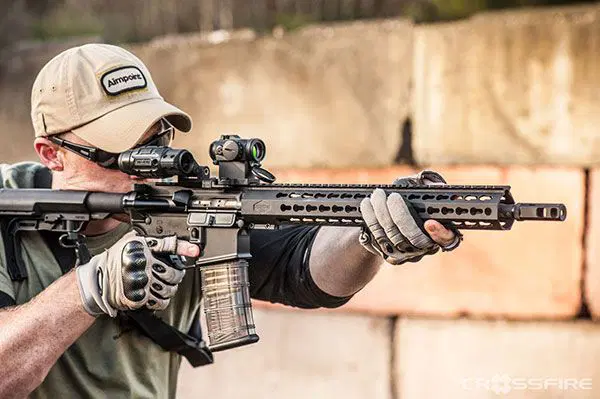In the world of competitive sports, athletes are constantly seeking ways to gain an edge over their opponents. Whether it’s precision shooting, archery, or even competitive pistol shooting, accuracy and speed are essential components of success. One technological innovation that has revolutionized the way athletes approach these sports is the reflex sight. These small, but powerful devices have become a game-changer in competitive sports, enhancing accuracy, speed, and overall performance. Here, we will discuss about the role of reflex sights in competitive sports and explore how they have transformed the landscape for athletes.

Understanding Reflex Sights
Reflex sights, also known as red dot sights or reflex optics, are optical devices designed to improve aiming accuracy by providing a point of aim in the form of a red dot or other reticle. Unlike traditional iron sights, reflex sights allow athletes to target their shots more quickly and accurately, regardless of lighting conditions or target distances. The concept behind reflex sights is relatively simple: a LED light source projects a reticle onto a coated lens, which then reflects the reticle back to the shooter’s eye. This creates a clear and illuminated point of aim that can be superimposed over the target.
The Benefits of Reflex Sights in Competitive Sports
1. Enhanced Accuracy
One of the most significant advantages of reflex sights in competitive sports is their ability to enhance accuracy. Athletes can place the red dot or reticle directly on their target, reducing the margin of error associated with traditional iron sights. This precision is particularly crucial in sports like competitive shooting, where fractions of an inch can make the difference between victory and defeat. Reflex sights, such as the Holosun EPS Carry, allow for improved shot placement, which can lead to higher scores and better performance.
2. Faster Target Acquisition
Speed is a critical element in many competitive sports, and reflex sights excel in this regard. Athletes can acquire their target quickly because the red dot or reticle is always in their line of sight, regardless of eye position or angle. This rapid target acquisition is invaluable in dynamic sports such as 3-gun competitions, where athletes must transition between multiple targets in the shortest possible time. Reflex sights enable athletes to react more swiftly, giving them a competitive edge.
3. Increased Comfort and Reduced Eye Strain
Using traditional iron sights often requires athletes to align the front and rear sights while focusing on the target. This process can be mentally and physically exhausting, leading to eye strain and fatigue over time. Reflex sights eliminate the need for such alignment, allowing athletes to focus solely on the target and the reticle. This results in increased comfort during prolonged competitions and less eye strain, improving overall performance.
4. Versatility in Lighting Conditions
Competitive sports often take place in various lighting conditions, from bright sunlight to low-light environments. Reflex sights are designed to adapt to these conditions. Many models feature adjustable brightness settings, allowing athletes to customize the intensity of the reticle to match the ambient lighting. This versatility ensures that the red dot remains visible and easy to acquire, regardless of the lighting conditions, giving athletes a consistent advantage.
Applications in Different Competitive Sports
Reflex sights have found applications in a wide range of competitive sports, each benefiting from their unique advantages.
1. Precision Shooting
In precision shooting sports such as IPSC (International Practical Shooting Confederation) and USPSA (United States Practical Shooting Association), athletes rely on reflex sights to engage targets accurately and rapidly. The speed and accuracy of reflex sights make them an ideal choice for competitive shooters, as they can quickly transition between multiple targets and achieve pinpoint accuracy.
2. Archery
Archers have also embraced reflex sights in both traditional and modern archery competitions. These sights assist archers in achieving consistent accuracy by providing a precise point of aim. They are particularly valuable for long-distance shooting and in windy conditions, where maintaining accuracy is challenging.
3. Competitive Pistol Shooting
Competitive pistol shooting events, such as IDPA (International Defensive Pistol Association) and Steel Challenge, have seen a surge in the use of reflex sights. These sights enable athletes to acquire targets quickly and accurately, resulting in faster times and higher scores. They also enhance situational awareness by allowing shooters to maintain a focus on the threat or target rather than the sights.
4. 3-Gun Competitions
3-gun competitions, which involve shooting rifles, shotguns, and pistols in various scenarios, require athletes to transition between weapons quickly and engage multiple targets. Reflex sights have become a standard accessory for 3-gun competitors, as they provide the speed and accuracy needed to excel in this demanding sport.
Conclusion:
Reflex sights have revolutionized the competitive sports landscape by offering athletes enhanced accuracy, rapid target acquisition, reduced eye strain, and adaptability to various lighting conditions. These advantages have made reflex sights a valuable tool in sports like precision shooting, archery, competitive pistol shooting, and 3-gun competitions. As technology continues to advance, we can expect reflex sights to play an even more significant role in improving athletes’ performance and pushing the boundaries of what is achievable in the world of competitive sports. Whether you are a seasoned competitor or a novice athlete, embracing reflex sights can help you take your performance to the next level, ultimately enhancing your chances of success in your chosen sport.